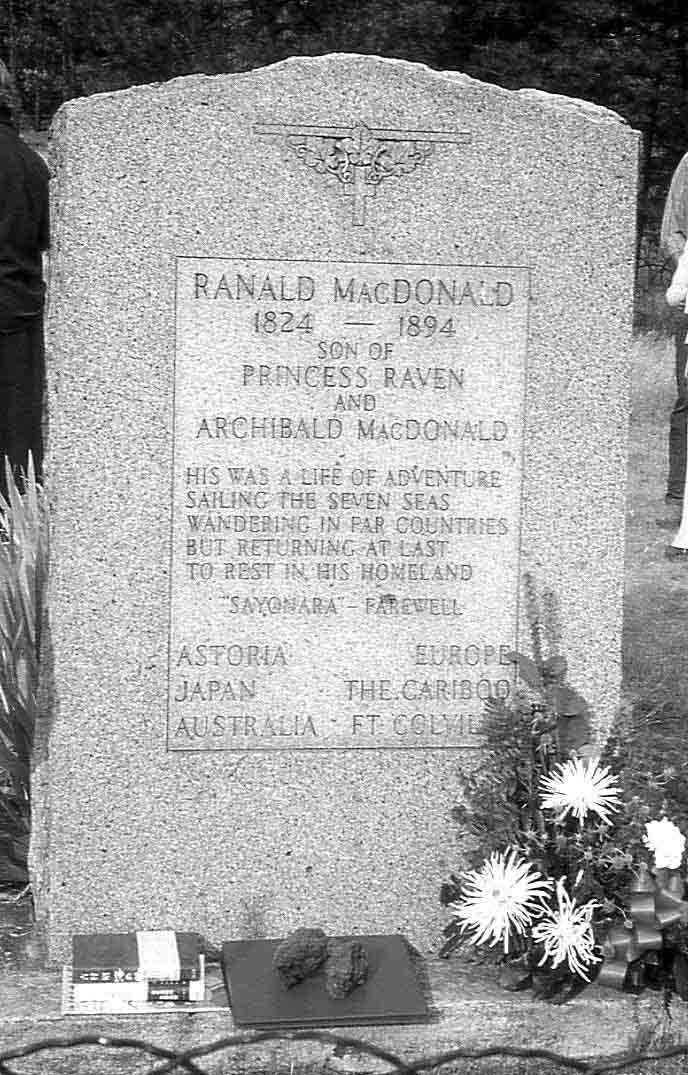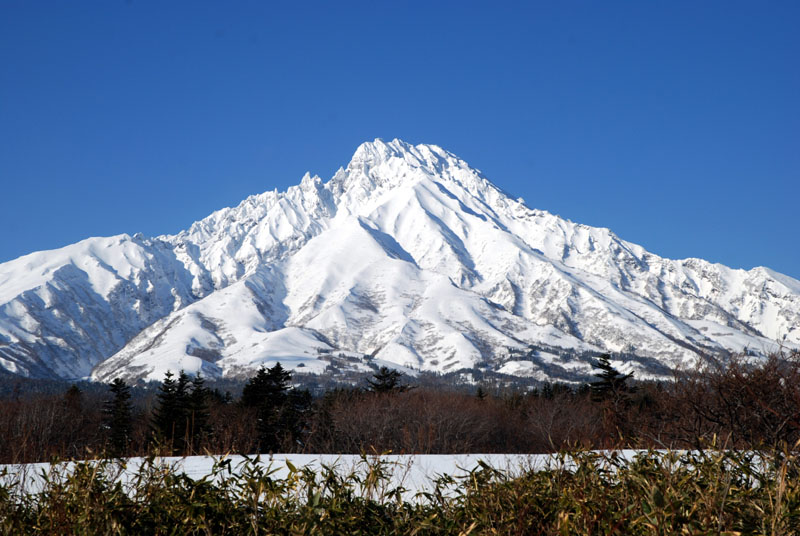FROM STICKS TO STONE: Monuments Tell MacDonald Story
He doth raise his country’s fame
with his own
And in the mouths of nations yet
unborn
His praises shall be sung; Death
comes to all
But great achievements raise a
monument
Which shall endure until the sun
grows cold….
~Georgius Fabricius (1516-1571)
1894 Ranald MacDonald, 70, suffering from some “pains in the joints”, had gone up the Kettle River to Toroda. His newly-widowed niece, Jennie Nelson, wanted his company. He died there, August 5, 1894, whispering the Japanese word for Farewell: “Sayonara, my dear, sayonara …”
He was buried in a desolate old Indian cemetery near Toroda, his grave unmarked and soon almost forgotten. However, a 1917 photograph shows a wooden cross, apparently the first of three markers mounted over the old traveler’s final resting place.
1938 FOM MEMBER Richard M. (Dick) Slagle of Republic, WA, was in the party which placed a cast concrete marker on the grave in 1938. He took photos of the ceremony with his “little $1 box camera”.
“I was a recent high school graduate,” he writes, “and in June of that year was approached by our local scoutmaster … He had been asked to have the Boy Scout troop participate in a ceremony at a grave and to make a marker. Not having any other information and only several days’ time, we set about the task of making a cement cross. When the cement was poured we scratched in the name as neatly as we could: Ranald MacDonald.
“On the day of the ceremony we loaded the cross into a school bus and rode to the Kettle River location, about 30 miles north of Republic. It was a warm summer day and about a dozen or so people assembled in the little Indian cemetery on the edge of a bench. It overlooks the Kettle River, the mouth of Toroda Creek and the ranch where Ranald MacDonald was visiting at the time of his death.
“Among the people gathered were Judge William C. Brown of Okanogan, a man with a lifelong interest in regional history and especially the history of the native people. Judge Brown had organized the vent and as he spoke I first heard the story of Ranald MacDonald.
“However, the high point of the program was to hear Mrs. Jennie Lynch (the former Jennie Nelson). At that time she was probably in her 70’s, an active Indian lady and a favorite of her uncle Ranald. As our group stood on this spot and looked over the scenic Kettle River valley she told the story of her memories of her uncle and his fondness to visit their ranch and of his last trip and final illness … ”
1951 The British Columbia Historical Quarterly reported on an event on October 27, 1951: The Committee on Historical Sites of the State Parks and Recreation of Washington held ” … a dedication service at the Indian Cemetery at Toroda, on the Kettle River, to mark the grave and honor the memory of Ranald MacDonald, one of the most colorful figures of the early fur-trade days, whose varied experiences took him as far afield as Japan.” Fifty-seven years after his death, the stone, which is still in place, told the story:

MacDonald’s grave with rocks from Rishiri Island. Photo by Frederik L. Schodt
Another 30 years passed. Then, as the Oregon-Japan connection gained strength, the story of Ranald MacDonald was rediscovered. In Japan, Prof. Torao Tomita published a translation of MacDonald’s memoir. The story was featured in a novel, “Ocean Festival“, by Akira Yoshimura. Other publications followed in Japan.
1987 On July 2, 1848, Ranald MacDonald made his official landing in Japan at Notsuka Cape on Rishiri island, just off the Hokkaido coast. Some 143 years later, on July 4, 1987, the Rishiri Rotary Club unveiled an historical monument erected on the rocky, black lava cape. The memorial was made from a rough log of Ezo-matsu (spruce) native to the small island. It was 3 meters (almost 10 feet) high and 35 centimeters (about 14 inches) in diameter. Vertical Japanese writing described Ranald MacDonald’s landing on this island. Next to the log was a large explanatory sign:
“The memorial stands facing the Pacific Ocean, looking out toward Oregon in North America,” says Masaki Takahashi. As a member of Rishiri Rotary, he first urged construction of the monument and four years later saw it unveiled. Funds were provided by Rotary and supervision by Prof. Jukichi Suzuki, a Rishiri native who strongly supported the concept of a commemorative marker for “the first spontaneous cultural exchange between Japan and North America.”
“Large numbers of tour buses stop every day,” says Dr. Takahashi. Tourists ” … admire and are excited by the brave deeds of MacDonald of Oregon, who was dedicated to mutual understanding between Japan and North America in a time long gone, and who took his life in his hands to achieve it, 140 years ago.” (The writer notes that, at the time Ranald MacDonald entered Japan, “it was a closed country, and entry by an outsider was usually punished by death …”
1988 A two-sided monument, Japanese text on one side , English on the other, was erected on the site of Fort Astoria, Ranald MacDonald’s birthplace. It was dedicated to his memory in sunlit ceremonies at Astoria, Oregon on May 21, 1988. [See Vol. 1 No. 1 of this newsletter for details.]
The monument is gray granite. A pentagonal bar across the top suggests the gate to a Japanese shrine. The text tells MacDonald’s story and also incorporates the names of organizations and individuals in Oregon and Japan whose gifts made the monument possible. The monument reflects a suggestion made almost 80 years ago by Eva Emery Dye, an early Northwest author who corresponded with MacDonald and published a book based on his life:
“Of all Oregonians,” she wrote, “Ranald MacDonald deserves a statue pointing to Japan.”
~ ~ ~ ~ ~
REPORT FROM ASTORIA – by Bruce Berney
From our perspective, many people have been involved in the promotion of knowledge about Ranald MacDonald. Probably the most valuable contribution has been the “living history” project at Ft. Astoria. Sponsored by the Clatsop County Historical Society with a grant from the Committee to Promote Astoria (which distributes income from motel tax), two young men, Brian Johnson and Troy Baker, dressed in the garb of fur traders of 1822, were on duty seven days a week to talk with visitors about important events at Ft. Astoria. Although the main topic is the founding of Ft. Astoria in 1811 as the first American business enterprise on the Pacific Coast, the presence of the Ranald MacDonald birthplace monument makes MacDonald’s life story an inescapable subject for discussion. It is estimated that 2,000 people heard the “trappers” during the past summer.
~ ~ ~ ~ ~
Mt Rishiri photograph by Eiji Nishiya

WHY ON RISHIRI? MacDonald’s Landing Place in Japan
(Some interesting points to ponder in connection with Ranald MacDonald’s initial landing in Japan are raised in the following material, provided by Masaki Takahashi and Yuji Ushiro of the Friends of MacDonald in Rishiri.)
RANALD MacDONALD BOARDED the whaler Plymouth for Japan in December 1845. About five miles southwest of Teuri and Yagashiri islands (off the west coast of Hokkaido) in June of 1848, Ranald left the Plymouth in a small boat. His efforts to land on Teuri were unsuccessful and he landed instead on the southwest beach of Yagishiri, where he spent two days. Early on July 1st he headed for Rishiri Island.
Why did he choose Rishiri Island after leaving Yagishiri? These may be the reasons:
1 – It’s likely that Ranald assumed Yagashiri was an inhabited island. To attain his purpose, he had to meet Japanese people. When he realized that Yagishiri was, in fact, uninhabited, he knew he had to find another place to land, hopefully a place with people. Ranald may have surmised that the mainland – Hokkaido – was too large to permit locating inhabitants easily. An island, on the other hand, would be small enough to find people. Rishiri has a high, snow-capped mountain peak and it is clearly visible on a clear day. Ranald may have assumed that, with such a large mountain, the people who lived there would have been forced to live along the beaches and thus be easier for him to find.
2 – Japan’s cruel treatment of foreigners was notorious. Ranald wanted to avoid danger. He may have reasoned that casting away on an island – rather than on the mainland – would afford him the best possible chance of meeting commoners rather than government officials (who would likely immediately capture him). He may have also thought that if there were fewer people, “commoners” rather than officials, they might be more sympathetic to his plight as a castaway and would be kind to him.
3 – If there were still no inhabitants (on Rishiri) he could move on to the mainland; to leave the mainland for one of the islands would have been more difficult.
4 – Douglas Williams – a reporter for Hokkaido Broadcasting Co., and a member of the film crew which visited Astoria for the monument dedication – thought that, because there is a high mountain in Oregon (Mt. Hood, which is quite visible from the Ft. Vancouver area where Ranald grew up) MacDonald may have unconsciously (or unconsciously?) have been drawn to Mt. Rishiri.
5 – From mid-June to July the shores of the Sea of Japan along the northern part of Hokkaido are often blanketed with thick fog. Mt. Rishiri may have been the only visible landmark. About 50 miles separate Yagishiri from Cape Notsuka, Rishiri; it is impossible to row all of the way from one island to the other. According to MacDonald’s own story, he sometimes hoisted a sail or simply allowed his small boat to be carried by the ocean currents. (Presumably the time he had spent in the Sea of Japan on the whaler Plymouth would have given him some knowledge of the currents thereabouts.) An experienced sea captain familiar with the area explains that tidal action alone could have carried MacDonald from Yagishiri to Rishiri.
Why Cape Notsuka? Wind. It likely carried Ranald’s small boat to Cape Notsuka on northern Rishiri rather than to Minamihama or another sandy beach on the southern coast.
~ ~ ~ ~ ~







